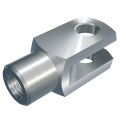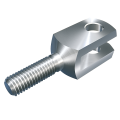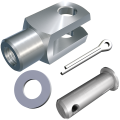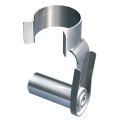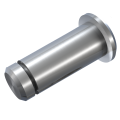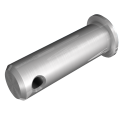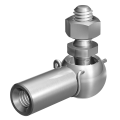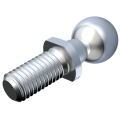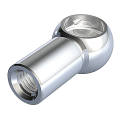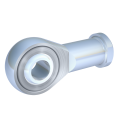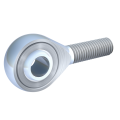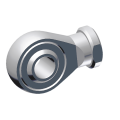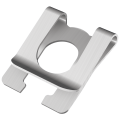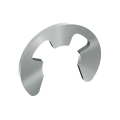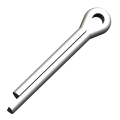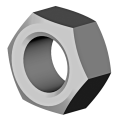1. Product description
We offer high-quality sealing caps for our angle joints according to DIN 71802, which have been specially developed to protect the gap between the ball socket and ball stud. Our sealing caps provide optimal protection against damage from environmental influences such as dust, dirt, splash water, and fumes.
The sealing caps are made of sturdy chloroprene and are thus usable in a wide temperature range from -30°C to +110°C. They can even withstand temperatures up to +140°C for short periods, emphasizing their versatility and durability.
Thanks to their versatile usability, our sealing caps are available for almost all standard versions of angle joints according to DIN 71802 and axial joints. Therefore, they ensure the best possible protection and a longer service life of joint connections in every industry and application.
2. Product details
Size: 8 - 19
Material group: Rubber
Surface: bright
Material: Chloroprene (CR)
Temperatures ranging: -30°C to +110°C (for short periods up to +140°C)
3. Application Areas & Compatibility
The use of sealing caps for angle joints DIN 71802 is particularly useful in environments and applications where protection against dust, dirt, splashes, and fumes is essential. Here are some specific application areas where sealing caps are particularly advantageous:
Mechanical engineering: Protection of joints in machinery and systems used in dusty or contaminated production environments.
Automotive engineering: Application in suspension components and steering mechanisms frequently exposed to dirt, water, and road dust.
Agricultural machinery: Protection of joint connections in tractors, combines, and other agricultural machinery operating under extremely dusty and often muddy conditions.
Construction machinery: Use in joints of excavators, wheel loaders, and other construction machinery working in dirty, wet, and abrasive environments.
Food industry: Application in areas where joint connections need to be protected from splashes and cleaning fumes.
Chemical industry: Protection of joint connections against aggressive fumes and chemicals that can be corrosive.
In these and many other areas, sealing caps for angle joints DIN 71802 offer outstanding protection and help ensure the functionality and longevity of connections.
Our sealing caps are available for almost all standard versions of angle joints according to DIN 71802.
4. Advantages and Benefits
Advantages
Comprehensive protection: Sealing caps protect the gap between the ball socket and ball stud from dust, dirt, splashing water, and vapors, maintaining joint integrity.
Extended lifespan: Protection against harmful environmental influences significantly extends the lifespan of the angle joints.
Durable material: The sealing caps are made of chloroprene, offering high resistance to mechanical stresses as well as chemicals, oils, and greases.
Use in wide temperature range: Usable in temperature ranges from -30°C to +110°C, and briefly up to +140°C, allowing versatile use in different environments.
High compatibility: The sealing caps are available for nearly all standard versions of angle joints according to DIN 71802, increasing flexibility in application.
Benefits
Reduced maintenance effort: Comprehensive protection reduces maintenance effort and decreases the necessity of frequent inspections and repairs.
Cost savings: Extending the lifespan and reducing maintenance effort result in significant savings in operating costs.
Operational safety: The reliability and functionality of machines and systems increase through the continuous protection of the joints, enhancing operational safety and efficiency.
Versatile application possibilities: Due to high compatibility and material properties, the sealing caps can be used in a wide range of industrial sectors and applications.
Eco-friendliness: Protecting angle joints reduces their replacement frequency, conserving resources and reducing environmental impact.
Easy installation: The sealing caps are easy to install, speeding up and simplifying the installation process.
The use of sealing caps for angle joints according to DIN 71802 thus offers numerous advantages and significant benefits for the durability and efficiency of mechanical linking elements in various industrial applications.
5. Assembly and Installation
Step 1: Choose the correct size of the sealing cap that fits the angle joint DIN 71802.
Step 2: Ensure that the angle joints are clean and free of dirt and debris.
Step 3: Slip the sealing cap over the ball of the ball stud and then insert the stud into the ball socket, ensuring that the sealing cap covers the gap between the ball socket and ball stud. It is important to ensure that the sealing cap sits evenly and completely on the joint without folds or gaps.
Step 4: Check the secure fit of the sealing cap to ensure no dirt or moisture can penetrate.
6. Safety instructions & Standards
Wear appropriate protective equipment: Use protective gloves and, if necessary, safety goggles during assembly to avoid injuries from sharp edges or tools.
Maintain a clean work environment: Ensure the work area is clean and free from debris to guarantee a contamination-free installation.
Check material compatibility: Before assembly, ensure that the sealing cap made of chloroprene is compatible with the lubricants and operating fluids used.
Select the correct size: Choose the correct size of the sealing cap to ensure optimal sealing and minimize the risk of overstretching or damage.
Regular inspection: Regularly check the sealing caps for wear or damage to replace them in time and ensure the protection of the angle joints.
Standards
DIN 71802: This standard defines the requirements and dimensions for angle joints for which the sealing caps are designed.
DIN ISO 1629: This standard contains the terms and definitions of elastomers, including chloroprene, from which the sealing caps are typically made.
Adhering to these safety instructions and standards ensures a safe and compliant use of the sealing caps for angle joints according to DIN 71802, which increases the durability and reliability of mechanical connections.

